We would love a boring quarter, but that’s not the outlook that Q2 2025 is bringing. As an uncertain tariff landscape piles onto an already high C market & a world plagued by uncertainty & geopolitical unrest, we’re focusing on building stability where we can. We’re moving decisively, getting into & out of origin quickly, & moving coffees as swiftly as we can—a strategy that has paid off in all of our landed coffees & most of our current incoming position being tariff-free. Ethiopia & Mexico containers are landing with more on the water. Coffees are selling about as fast as we can bring them in, sometimes faster, so make sure to get in touch with us about your needs & so we can do our best to ensure they’re met.
Read on for the scoop on logistics, the C market, & every origin in which we work. Click here to listen.
Logistics, Port, & Warehouse Updates
 The shifting landscape of the Trump administration’s new tariff policies will have far-reaching consequences on the global shipping industry, affecting global trade patterns, shipping costs, logistics operations, & market dynamics. Uncertainty remains high. Ocean freight carriers, port operators, shippers, & importers are all bracing for upheavals. Trade routes are expected to shift, as shippers shift cargo volumes away from China to countries with lower tariff rates.
The shifting landscape of the Trump administration’s new tariff policies will have far-reaching consequences on the global shipping industry, affecting global trade patterns, shipping costs, logistics operations, & market dynamics. Uncertainty remains high. Ocean freight carriers, port operators, shippers, & importers are all bracing for upheavals. Trade routes are expected to shift, as shippers shift cargo volumes away from China to countries with lower tariff rates.
Adapting to route changes requires reallocating vessel capacity, often increasing blank sailings, & generally causing instability throughout the industry—congestion in some places, container shortages in others, & likely increases in costs in the near term. The tariff situation also adds complexity for importers as the administrative & compliance burden falls on them to navigate shifting tariff schedules & classification codes, which could make clearing goods through US ports slower & less efficient.
An additional challenge looming on the horizon is a proposal by the White House & the Office of the US Trade Representative (USTR) to impose heavy fees on any Chinese-built or linked vessel calling at US ports. The fines of up to $1.5 million per US port call have faced heavy pushback from many US industries, from coal to agriculture. The administration is rumored to be considering softening the proposal, but uncertainty remains high & the impacts could be significant. Chinese-built vessels constitute up to 80% of the current global shipping fleet.
Currently, as the world waits to better understand the fallout from the new tariff reality, US ports are relatively congestion-free with no imminent labor contract negotiations or disruptions. The situation in the Suez Canal remains basically unchanged—carriers are not positioned to return to any Suez transits in the near future.
In Mexico—where Red Fox is currently in the midst of shipping season—many Mexican exporting companies are facing difficulties in transporting goods to the US. We are seeing shortages of 20ft containers & increases in freight costs. Customs clearance at the Mexico/US border has been helpful during this period. Although congestion is typical, the efficiency of the clearance process has somewhat eased the situation. As businesses try to secure inventory before the tariffs take full effect, clear communication with warehouses is essential for ensuring organized delivery & avoiding additional costs.
Supply, Demand, & The C Market
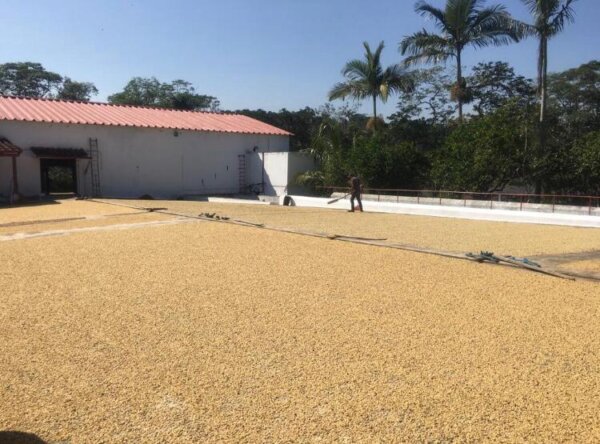 As we move deeper into 2025, the coffee market continues to navigate a complex landscape shaped by shifting supply chains & rising geopolitical tensions—most notably, new, still-fluid tariff policies affecting key coffee-exporting nations. While green coffee that Red Fox is currently moving remains tariff-exempt in most cases at this time, costs have climbed & the market is still reeling from historic highs earlier this year.
As we move deeper into 2025, the coffee market continues to navigate a complex landscape shaped by shifting supply chains & rising geopolitical tensions—most notably, new, still-fluid tariff policies affecting key coffee-exporting nations. While green coffee that Red Fox is currently moving remains tariff-exempt in most cases at this time, costs have climbed & the market is still reeling from historic highs earlier this year.
At time of writing, the C market seems to be hovering around $3.50/lb after hitting an all-time industry high of $4.41/lb in February 2025. US implementation of global tariffs triggered a general dip in the stock market, & the C market fell alongside it. Institutional investors anticipate a potential drop in demand as the economy remains in flux. Without concrete signs of supply relief from Brazil on the immediate horizon, the market lacks any substantive evidence of short- or long-term relief. The potential institution of tariffs, & subsequent tanking markets, may be the only driving force to bring the C market down in the next quarter or so. We don’t know what to expect.
The immediate trading months in front of us remain in the mid $3.00 range, which would previously constitute an all-time high above 1977 levels. Costs on tariffs bring levels back closer to, or above, $4.00/lb.
At time of writing, all coffee-producing origins aside from Mexico are subject to tariffs ranging from 10-46%, currently paused at 10% for 90 days, on containers that received a Bill of Lading on or after April 5.
As the dust has settled around these new coffee industry dynamics, liquidity becomes the central concern for the trade. To put it simply, our collective dollar goes about 30-40% as far as it used to—& that’s in the best case scenario under these market conditions. The questions become, “Where do we want to continue our investment?”, “Where are the best values for our clients today and where will they be tomorrow, next quarter, etc.?” Fortunately our supply chains in Mexico, Ethiopia, & Peru have proven resilient with Kenya, Tanzania, Rwanda, & Bolivia additionally presenting excellent value propositions.
For now, agility remains key. Buyers with diversified sourcing strategies, strong supplier relationships, & a clear sense of their customers’ value priorities are best positioned to ride out the market volatility & continue to provide value at the middle links of the supply chain. Red Fox will continue to reliably source consistent quality coffees. We are here to provide you with stability & help you navigate the un-navigable.
Mexico
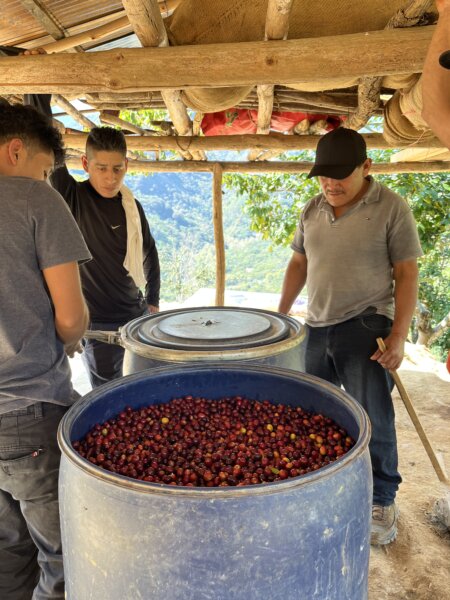 The harvest in Mexico is almost fully wrapped up, with most of the coffee off the trees & in dried parchment form across the country. Milling & shipping are in full swing. Samples continue to arrive at our Oaxaca lab. Our team is busy cupping & approving coffee, building lots sample by sample, & scheduling & executing milling & export from all 4 states we source from.
The harvest in Mexico is almost fully wrapped up, with most of the coffee off the trees & in dried parchment form across the country. Milling & shipping are in full swing. Samples continue to arrive at our Oaxaca lab. Our team is busy cupping & approving coffee, building lots sample by sample, & scheduling & executing milling & export from all 4 states we source from.
Harvest yields are down somewhat in Oaxaca, particularly Sierra Sur & Mixteca, up in Veracruz, & relatively flat in Puebla & Chiapas over last year. Weather has been favorable for coffee production aside from mid-season rains in Sierra Sur that caused some premature flowering.
This year’s saving grace amidst an extremely volatile & historically high price environment has been the standout quality we continue to see this harvest from every region & source we work with. Constant communication & frequent field visits have been integral in maintaining relationships with farmers & ensuring that the flow of top-quality coffee continues. With the early threat of (higher) tariffs looming in the season, we moved quickly to build a new overland transportation route into Texas & moved first containers directly to the warehouse in Houston from Oaxaca & Veracruz.
Our current understanding is that Mexican coffee is tariff-free under USMCA (US–Mexico–Canada Agreement, a trade agreement) making it the only non-US coffee origin currently escaping tariffs.
Available Lots
Fresh arrivals from Oaxaca & Veracruz of top community lots are now available in Dupuy, Houston. We can move to other warehouses as needed—however, lots are getting allocated & scooped up quickly, especially sans tariff, so don’t delay in reaching out to your rep to get more info & request samples to secure your coffees.
Ethiopia
 In our eyes, Ethiopia appears to be home to the greatest value proposition in our industry at the moment. While government minimum FOB levels have brought prices higher than ever in our collective coffee careers, they remain lower than most Latin American FOB levels through Q1 & into Q2.
In our eyes, Ethiopia appears to be home to the greatest value proposition in our industry at the moment. While government minimum FOB levels have brought prices higher than ever in our collective coffee careers, they remain lower than most Latin American FOB levels through Q1 & into Q2.
Lower-grade Ethiopian coffee has gained traction throughout the harvest & shipping seasons as a Brazil replacement with roasters across the globe, in particular Grade 5. Naturals have also seen strong general demand with offers beginning to dry up across the country. Export reports over the past 12 months appear to show natural production at 4x that of washed coffee production.
As a reaction to tariffs & spiraling global markets, government-mandated minimum FOB price levels have once again dropped in consecutive weeks.
Ethiopia will be subject to a 10% reciprocal tariff on coffees going afloat after April 5th (at time of writing).
We moved earlier than ever this year, making 3 different sourcing & quality assurance trips to Ethiopia between December & March. Over 70% of our Ethiopian selections were afloat prior to the tariff announcements. The vast majority of our fresh crop Ethiopian coffees are either spot at Continental Terminals NJ or afloat. These are tariff-free coffees.
Available Lots
We have top Bensa, Chire, & Shakiso washed G2 lots available at Continental Terminals NJ. Get in touch with your rep while they’re still available.
We have a full-menu range of top G1 & G2 washed & natural lots coming into Port of NJ later this month & next and containers hitting the Port of Oakland beginning late May. The vast majority shipped before tariffs went into place.
Kenya
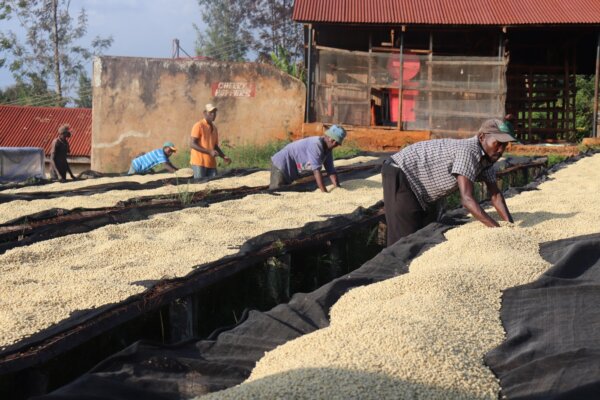 The main crop in Kenya is winding down. This harvest saw record-high prices for farmers due to the high market. Our partners in Nairobi are seeing a renewed interest in farm investment because of high prices received for coffee this season.
The main crop in Kenya is winding down. This harvest saw record-high prices for farmers due to the high market. Our partners in Nairobi are seeing a renewed interest in farm investment because of high prices received for coffee this season.
Fly crop will likely begin harvest in May due to beneficial mid-March rains & healthy flowering that followed. Current expectations are for high quality due to a more regular weather cycle between harvests.
Shipping out of Mombasa this year was smooth as it has been the past 2 years, leading to our first 2 containers clearing into Continental NJ. Our 2 remaining containers are just over a month away, with increasingly limited lots available. They were all shipped before tariffs went into play and will be tariff-free.
Available Lots
We’ve still got small quantities of coffee from Kamwangi & Kiamugumo available from our later delivery. Reach out to your rep before they’re gone.
Tanzania
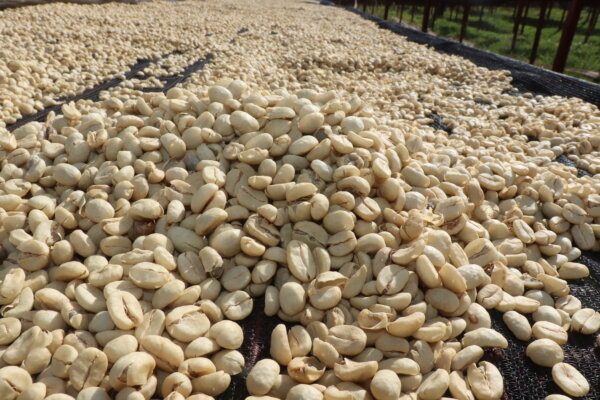 Our first Tanzanian coffees have cleared Continental Terminals & are on their way to roasters in time for spring menus. They also got in ahead of tariffs and are tariff-free. We couldn’t be happier with how these coffees are performing. We look forward to continuing to grow our purchasing in Tanzania with our partners there.
Our first Tanzanian coffees have cleared Continental Terminals & are on their way to roasters in time for spring menus. They also got in ahead of tariffs and are tariff-free. We couldn’t be happier with how these coffees are performing. We look forward to continuing to grow our purchasing in Tanzania with our partners there.
Harvest will begin in May since this is an off-cycle year in their biennial crop cycle. Early quality indicators look promising, with arabica volumes estimated between 35,000 & 40,000 metric tons. Partners there expect crop volumes similar to last harvest, though the harvest timeline starts earlier in off-years.
Tanzania is also growing nearly an equal amount of robusta to arabica, & recently won Taste of Harvest from the African Fine Coffee Association in the category. Given the spike in prices in the robusta market since early 2024, we’re likely to see continued interest from small producers planting robusta due to rising demand. We hope that offering high prices & a focus on quality will continue to make top lot arabica worthwhile for our partner farms & producers.
Available Lots
There is still a very small amount of Tanzanian coffee available from Mondul & Burka estates at time of writing, free of tariffs. Reach out to your sales rep to grab the last few bags.
Bolivia
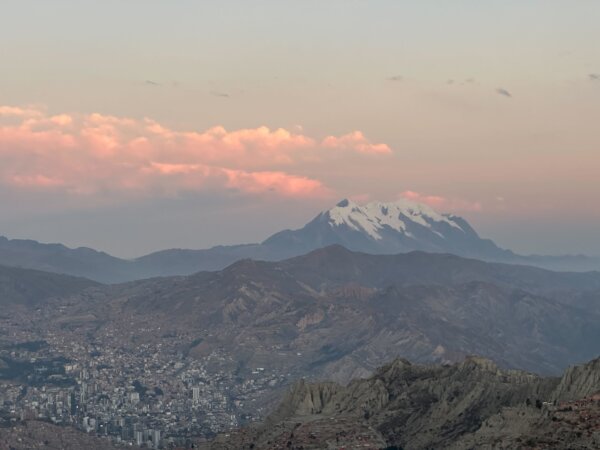 Among the most immediate news in Bolivia is concern around lack of resources. Gasoline is becoming a rare commodity with inconsistent availability, affecting the entire country. Our supply chain partners in Caranavi report issues “making it tough to move personnel & cherry.” Inflation levels appear to be above 14% at the time of writing.
Among the most immediate news in Bolivia is concern around lack of resources. Gasoline is becoming a rare commodity with inconsistent availability, affecting the entire country. Our supply chain partners in Caranavi report issues “making it tough to move personnel & cherry.” Inflation levels appear to be above 14% at the time of writing.
Presidential elections will be held later this summer, with some expecting change towards the Center-Right party. Former President Evo Morales, from the Leftist party, announced his candidacy over a month ago which would defy Bolivia’s presidential term limits.
The rainy season has extended into the earliest part of the harvest at lower altitudes. Expectations are for rains to stop with enough time for cherry to mature later this summer into fall. Assuming weather behaves as planned, the early prognosis is for a strong harvest in the Yungas.
Available Lots
Sold out until next season. Keep an eye out for info on forward booking for the upcoming crop this summer.
Peru
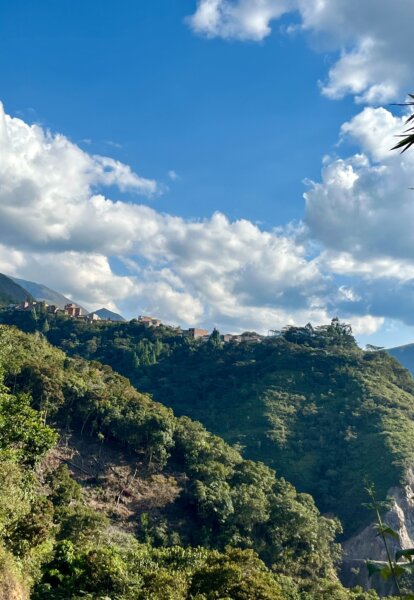 Although the coffee harvest at higher-altitude farms in Peru is a couple months away, it’s still a busy time of year for coffee producers & producer organizations. During these months, coffee producers are preparing their farms for the upcoming season: weeding & maintaining their coffee trees, calibrating depulping machines, maintaining & upgrading wet milling & drying infrastructure, & participating in internal inspections conducted by producer groups to prepare for certification audits & to comply with EUDR requirements. The regulation will start in January 2026 for all coffee entering the European Union.
Although the coffee harvest at higher-altitude farms in Peru is a couple months away, it’s still a busy time of year for coffee producers & producer organizations. During these months, coffee producers are preparing their farms for the upcoming season: weeding & maintaining their coffee trees, calibrating depulping machines, maintaining & upgrading wet milling & drying infrastructure, & participating in internal inspections conducted by producer groups to prepare for certification audits & to comply with EUDR requirements. The regulation will start in January 2026 for all coffee entering the European Union.
For producer organizations, securing financing for parchment purchases is a top priority. Managers have been meeting with banks & other lenders to discuss financing needs for the upcoming season & prepare the documentation required to apply. Many of the producer groups either recently held or are preparing to hold their general assembly meetings to review their 2024 financial performance & accomplishments, receive their final payments & quality premiums, & in some cases elect new board members to replace those whose terms are up. Organizations are also in the process of being audited to renew their Fairtrade & Organic certifications.
Rains in many of Peru’s coffee-producing regions have increased in the past weeks, especially in the south. Strong rains are ideal for coffee plants at this time of the year but troublesome for producers’ day-to-day lives. Complications include landslides leading to road closures, particularly those that connect small towns with big cities where producers travel for groceries & basics, as well as elevated river-flow in key crossings.
Meanwhile in the north, continuous rains are helping crop growth & bean development, but causing soil erosion in lower areas.
Available Lots
Keep an eye out for info on forward booking for the upcoming crop this summer and shipping soon after.
Colombia
 Heavy rains have pushed the first semester harvest (La Mitaca) back into the summer with certain areas of Southern Colombia (Huila, Southern Cauca, & others) expected to have a smaller Mitaca & larger second semester harvest. That said, current national projections are for a better year than last year, with February’s output significantly greater than February 2024. 12-month production levels closed in on 15 million bags, the highest Colombian coffee production levels in decades.
Heavy rains have pushed the first semester harvest (La Mitaca) back into the summer with certain areas of Southern Colombia (Huila, Southern Cauca, & others) expected to have a smaller Mitaca & larger second semester harvest. That said, current national projections are for a better year than last year, with February’s output significantly greater than February 2024. 12-month production levels closed in on 15 million bags, the highest Colombian coffee production levels in decades.
Nariño’s harvest is going beautifully, with ideal rain conditions since 2025’s optimal flowering. Our partners here are optimistic that this harvest will be much stronger than the last few years, which suffered under suboptimal weather conditions. Market instability has jumpstarted sales of early-harvest coffee to the highest bidder, with unprecedented prices. Our year-over-year producer partners seem to be as focused on quality as ever this season.
The rains in Inzá on the other hand have been intense, which will likely make for a more challenging harvest come May & June. Our partners here anticipate a smaller yield & we will continue to focus on quality & adding value.
Ports are saturated & have reported delays & adjustments for several months now.
Inflation continues at levels above 5%.
Politically, armed groups have made life in Cauca more challenging. Clashes to control the area have increased, & there are some blockades of basic staples for the population as well as illegal checkpoints limiting freedom of movement & beyond government reach.
President Petro demanded the resignation of members of his cabinet in February after they criticized him, which caused global concern about his ability to lead.
Available Lots
We are currently sold out. New crop will begin shipping at the end of summer.
Rwanda
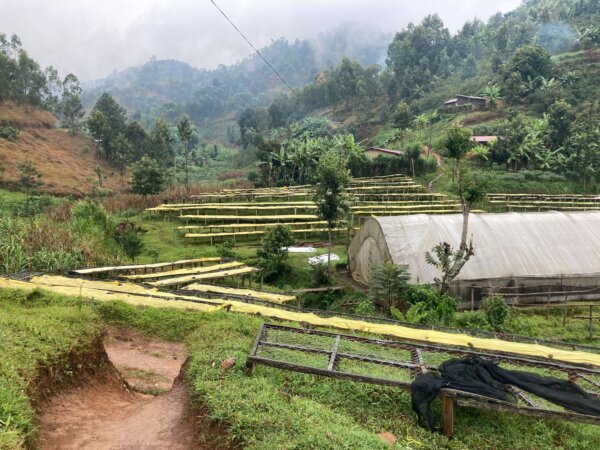 The 2025 season is shaping up to be exceptional, marked by both increased volumes & strong market prices. Across the Kanzu region—& Rwanda as a whole—this year’s harvest is notably higher than the past 5 years, in part due to the cyclical nature of coffee production.
The 2025 season is shaping up to be exceptional, marked by both increased volumes & strong market prices. Across the Kanzu region—& Rwanda as a whole—this year’s harvest is notably higher than the past 5 years, in part due to the cyclical nature of coffee production.
In the Kanzu region, weather conditions have been favorable with moderate & well-timed rainfall supporting the maturation & ripening of coffee cherries. C. Dorman has continued to support farmers by distributing foliar fertilizer at no cost. This has been applied twice & significantly aided the coffee cherries through their maturation phase. Additionally, farmers supplying to Kanzu have consistently implemented the best agricultural practices, as reinforced in past training sessions. Recent field visits confirm that the farms & their crops are healthy & that cherries being delivered to the station are of outstanding quality.
In recent weeks, the New York market was on an upward trajectory, influencing a significant & somewhat speculative rise in cherry prices, especially in Nyamasheke District. While the market has since begun to soften, cherry-buying competition remains intense.
Kanzu began receiving & processing cherry in early March, & there is now a good volume of high-quality parchment currently drying on raised beds. The harvest is expected to continue until the end of July.
Available Lots
We are currently sold out of Rwandan coffee. Keep an eye out for info on forward booking for the upcoming crop this summer.
Guatemala
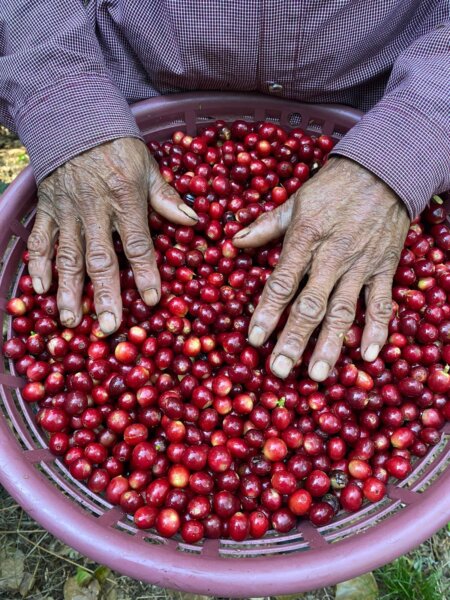 The 24/25 harvest is nearly complete. Due to late rains & accompanying delayed flowering, Guatemala’s 2025 coffee production is projected at 10-15% lower than 2024’s, though our sourcing partners report slightly higher yields in Huehuetenango this year.
The 24/25 harvest is nearly complete. Due to late rains & accompanying delayed flowering, Guatemala’s 2025 coffee production is projected at 10-15% lower than 2024’s, though our sourcing partners report slightly higher yields in Huehuetenango this year.
Migrant labor shortages continue to affect the cost of production, while the high C-market has brought financing issues for exporters across the globe.
Available Lots
We are currently receiving & evaluating offers from previous supply chain partners in Huehuetenango. Business will be concluded one way or another by the end of the month. Stay tuned for updates.
Interested in sourcing coffee with us? Reach out at info@redfoxcoffeemerchants.com. To learn more about our work, check out our journal and follow us on Instagram @redfoxcoffeemerchants.
